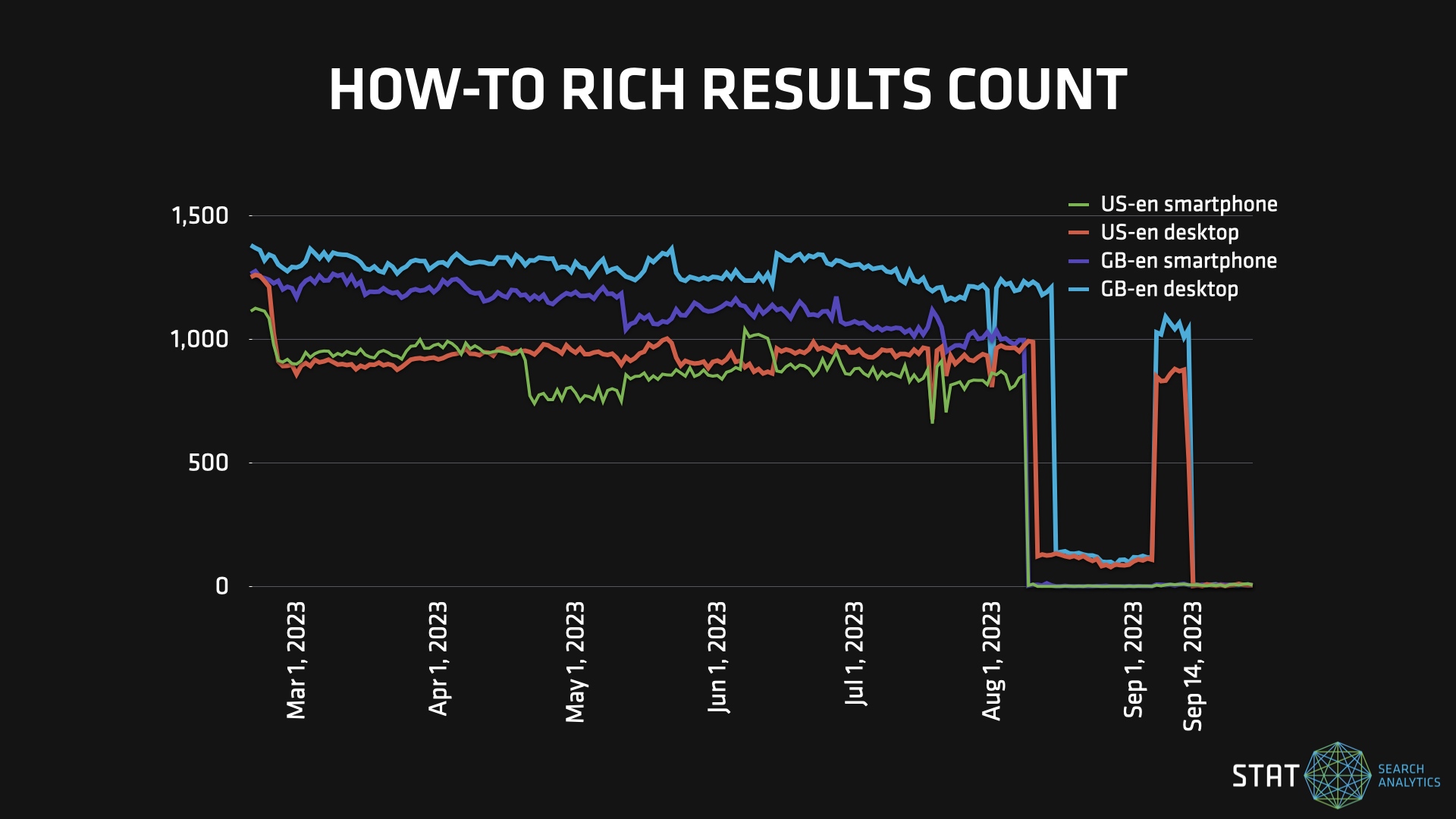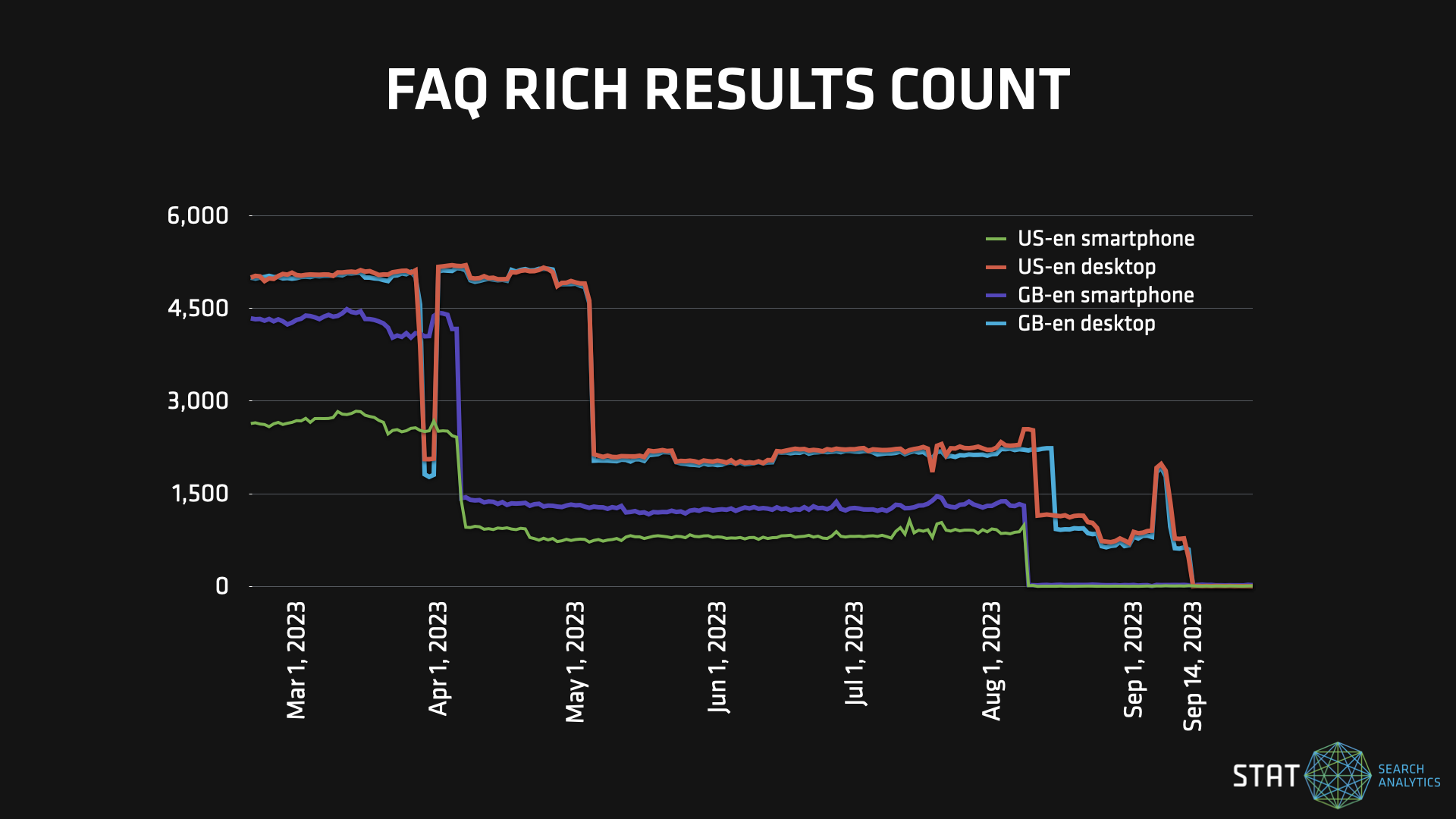Change is afoot — we’ll be seeing a lot less of two long-standing rich result types going forward.
In July, we documented the recent and significant drop in FAQ rich result prevalence, and pointed out the somewhat dubious record of FAQ especially. In short, this was a feature that had historically been a little bit too open to abuse, which was arguably never fully solved.
Well, it seems Google enjoyed our post, and while we were busy enjoying ourselves at MozCon in August, they announced that they would be further reducing the visibility of both FAQ and the closely related How-to.
This looks to be a very impactful change, but it’s also interesting for a couple of other reasons:
- Firstly, Google does not usually acknowledge or justify changes like this.
- Secondly, this is a truly precipitous drop, and some are speculating that it might be preparing us for a Search Generative Experience rollout. (We don’t necessarily agree, but more on that later).
Let’s break down the what, when, and why behind this update.
What?
There’s a bit more nuance than just both features reducing in visibility.
For How-to, the announced change is that it’s going desktop-only. This means there’s no major tactical implication for marketers, other than that the ROI of pursuing this rich result just got significantly lower, especially if you’re in a vertical where a lot of users are searching on smartphones.
As we’ll discuss further below, Google may be rather underselling the scale of their changes to How-to prevalence — so far at least, this is even larger than the smartphone wipeout they announced.
For FAQs, the change is that they’re only going to be visible for high authority sites. This is obviously far more tactically significant — it’s been common practice in recent years for SEOs to stick FAQ markup anywhere and everywhere, even adding FAQs to pages specifically to trigger this rich result.
With this change, it’s probably only worth marking up FAQs that already exist and are actually useful to the user, and the reward for adding that markup is similar to any other markup that isn’t tied to a search feature: you’re helping Google and other crawlers understand your content, but you’re probably not going to get any direct click-through rate benefit.
When?
We started seeing drastic drops on smartphone for both features on 9th August (one day after Google’s announcement). US-en desktop followed a couple of days later, on the 11th. As of yet, we don’t see a similar drop for GB-en desktop, but it seems likely that we will any day now.
FAQ prevalence over time
Here we see prevalence on smartphone plummet almost to zero, and a recent dip for desktop occurrences (in the US, so far).
How-To prevalence over time
How-tos shared a similar fate to FAQs, with smartphone prevalence practically vanishing overnight, and a massive drop on desktop (in the US, so far).
Those precipitous drops bottom out at no more than 20 instances of each feature on smartphone across the 10,000 MozCast keywords used in our study.
US-en desktop is not quite so extreme, down to roughly half the recent stable level for FAQs, and less than 15% of the previous stable level for How-to.
This is curious, as the initial announcement did not make it sound like How-to would be the main loser, especially on desktop!
Desktop top 10: stable… for now
A closer look at US-en desktop share of voice
Looking at share of voice, the August 11th change in prevalence did not result in a noticeable drop leading us to believe this update mostly affected lower organic ranking positions.
Looking at share of voice, the August 11th change in prevalence did not result in a noticeable drop leading us to believe this update mostly affected lower organic ranking positions. For US-en desktop, it also seems likely that so far this most recent change is only affecting lower ranking positions.
We can see in the chart above that share of voice is holding steady after August 11th, despite the big drop in prevalence visible in the charts above. This usually indicates that the top 10 organic results — which are the only results that significantly affect share of voice — are stable.
Why?
Although the initial announcement is pretty matter of fact, Google shared some additional context on Twitter (or, X? We’re never quite sure these days) via the Search Central account. The reason, they say, is “to provide a cleaner and more consistent search experience.”
The choice to do this only on smartphone devices — for How-to at least — aligns with the “cleaner” part in particular. With the limited real estate on mobile SERPs, these features are perhaps just too messy.
The decision to leave FAQs in place for certain “well-known, authoritative government and health websites” also sounds like Google shares the industry’s long-standing concerns about how easily abused this feature is.
We’ve seen some speculation on Twitter to the effect that this might be to make room for an SGE rollout. This is quite a bold guess right now — SGEs don’t look ready for primetime just yet, so if this was the goal here, it’d make more sense to delay this change until the newer feature was finalized and there to fill the space.
It seems likely that there’s more movement in store for both of these features — GB-en desktop has yet to catch up, and Google may also still be experimenting here — stay tuned and watch this space.
September 2023 Update — R.I.P. FAQ & How-to rich results
After what looks like some peculiar second thoughts in early September, Google finally pulled the plug on these features on September 14th, 2023.
FAQ & How-to-mageddon
On September 14, 2023 we waved goodbye to FAQ and How-to rich results.

They provided some accompanying commentary at the top of their original post, explaining the goal of a cleaner SERP. Google’s Gary Illyes went further at an event on September 21st, saying “The ultimate goal is not for AI. It is to make results that look clean. We’re not freeing up space for x or y,” which happily agrees with our take above.






